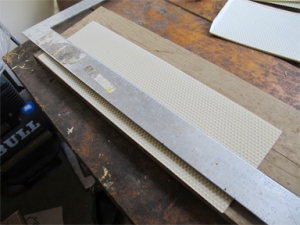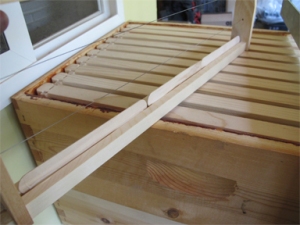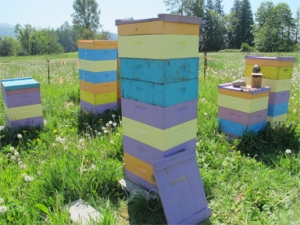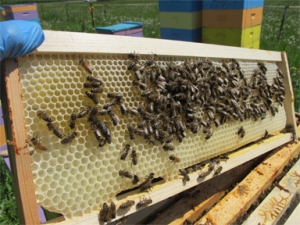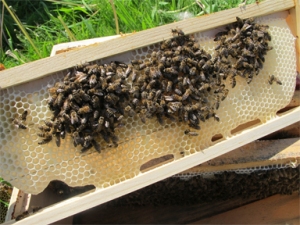I’ve previously posted about the myriad of choices in beehive foundation. This post is about an experiment I’m running this year with Foundationless Frames and Frames Hung With Half-Sheets of Wax Foundation. I’ll call these “Half-Hung” frames to make writing easier. (By the way, the Paria Canyon post is still to come, there are just so many wonderful pictures to sort though – and foundation is way more relevant to beekeeping).
Background
Foundationless Frames have always seemed to me to be an attractive option. The bees get to build what they want to build. I don’t pay for foundation. But it has never been terribly successful for me. Often the bees just ignore the foundationless frames and work on all the other frames.
Two years ago I worked with a beekeeper friend, Clyde. Clyde works with small cell foundation in deeps, but he only places foundation on the top half of the frame. This technique seemed attractive as well : bees get to build what they want on half the frame, and foundation for each frame costs me 50% less. I know I sound mercenary, but it can be challenging making a living as a beekeeper.
Beekeeper Clyde at Paria Canyon Trailhead
(yep, I did work in a picture from the trail head at Paria Canyon – Clyde was in the area and gave me a lift to the beginning of the walk – My truck was 40 miles down river).
I run about 50 hives. These hives are in a number of bee yards in eastern Whatcom County, Washington, where I live. About half the hives are in agricultural lands. The other half is up-river in the foothills of Mt. Baker (where my farm is located). I only use medium boxes (“westerns”) in my beekeeping – no shallows or deeps.
The Experiment
Both foundationless and half-hung frames were wired in my usual way.
The half-hung foundations are pretty straightforward. I cut each wax foundation in half, then mounted it on the frame and hot-wired it to the top wire.
Cutting the Foundation
A Half-Sheet of Hung Foundation
The foundationless frames were a bit more time and space consuming. I used wood glue to secure large Popsicle sticks (bought at a craft store), into the top groove of the frame. The time is in waiting for the glue to harden.
Items to prepare foundationless frames
Waiting for Glue to dry on upside down foundationless
With half-hung it’s: hot wire wax foundation, then foundation goes in box. With foundationless it’s : turn frame upside down and wait for the glue to dry.
Each hive got one foundationless frame and one half-hung frame. These frames were put in at positions 2 and 9 in my ten frame hives.
Each type of frame was hung between two drawn foundations (that’s important). They were never put next to each other or next to a sheet of foundation.
None of the hives are level. They do not have an extreme lean, but they do slightly tilt in all directions (I use a wire bottom, so drainage is never an issue in my hives)
About 10 days later I returned to some of the hives, because I wanted to split them. This gave me an opportunity to see how the experiment is progressing.
Current Conditions:
1) We are in the middle of a large “honey flow” : lots of flowers, lots of nectar.
2) The hives I checked were the strong hives from which I had chosen to breed new queens, and/or were in dire need of being split before they swarmed.
Observations:
1) Both the Foundationless and Half-Hung frames were being drawn out. The degree varied from hive to hive.
Half-Hung Foundation on a stronger hive. Hive “A” for this post.
A smaller hive’s work with half-hung foundation. Hive “B” for this post.
Foundationless Frame in stronger hive “A”
A foundationless efforts in hive “B”
2) Both types of frames were straight as can be – I attribute this to having drawn foundation on either side of each frame. See above images.
3) The bees did draw out the Half-Hung frames faster than the foundationless. See above images.
4) Foundationless frames were all drone-sized cells (many filled with honey). See the second and fouth image above.
5) Half-Hung frames were worker-sized cells on top (where the foundation was) and drone-sized cells on the bottom. It will be interesting to see if this influences the mite counts. See the first and third image above.
6) Regarding points 4 & 5 : These frames are in positions 2 and 8, where bees tend to build drones. (I shall drop some towards the center on a checker boarded hive soon, and see what that produces – the link is to a very nice explanation of how to checkboard a hive from Honey Bee Suite ).
Conclusion:
So far so good. I’ll make up some more half-hung, and foundationless (if I have the time for the latter – time and space needed for drying are a pain.
The Future:
It will be interesting to see:
1) If the foundationless and half-hung frames seem to have an effect of bee health.
2) If they have an effect on mite counts.
3) If the bees continue building them during a standard honey flow.
4) If weaker hives and nucs build on them.
I’ll let you know what happens.
Are you trying anything new this year? If so do share what you’re doing and the results – it’s great when we can all learn new things together.
Also, if you have any words of wisdom about Foundationless or Half-Hung hives please share. The good sides, the bad sides….
That’s the news from Brookfield Farm Bees And Honey – outside of the frames, I’m splitting hives, raising queens, doing farmers markets, and have brought in a Livestock Guard Dog Puppy, and three Muscovy Ducks (I’m new to ducks). These latter came from my beekeeper friend Lisa at Round Tuit Farm . Check out her farm – and honey – on her website and at her farmers markets.


